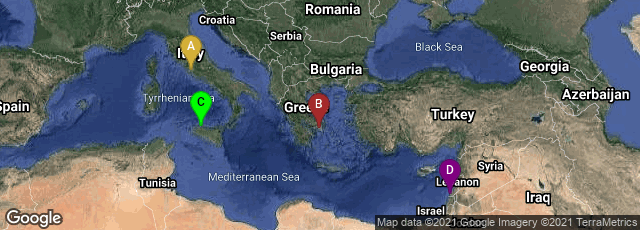Painting from the early 18th century that Includes a Porphyrian tree. Bad Schussenried, Kloster Schussenried, Neuer Konventsbau, Bibliothekssaal Deckenfresko, Ausschnitt: Baum des Porphyrius. Painting by Franz Georg Hermann (1692–1768)

A: Roma, Lazio, Italy, B: Athina, Greece, C: Palermo, Sicilia, Italy, D: South Governorate, Lebanon
Porphyrian tree from fol. 7v of LJS 457. Loyca parva ... etc. By Paolo, Veneto, ca. 1370-1428 or Paolo della Pergola, d. 1455
Written in the abbey of the Hermits of Saint Augustine in Perugia in 1475 (f. 87r). University of Pennsylvania Libraries.
About 270 Neoplatonic philosopher Porphyry of Tyre (Πορφύριος, Porphyrios) published his Introduction (εἰσαγωγή, Isagoge) to logic, perhaps while he was in Rome. In this work, which was translated into Latin by Anicus Manlius Severinus Boëthius, and remained a disseminated and copied text throughout the Middle Ages, Porphyrios reframed the predictables (praedicamenta) defined by Aristotle in his Organon into a list of five classes: genus (genos), species (eidos), difference (diaphora), property (idion), and accident (sumbebekos). From these Porphyrios created the scala praedicamentalis, or Porphyrian Tree (Tree of Porphyry, Arbor Porphyriana).
Porphyry's introduction was the most successful work of its kind ever published. Translated into many languages, for 1500 years every student read it as the first text on its subject. As a result, its influence was immense in philosophy and logic, and in the organization of knowledge, and its visualization in arborial form.
"Expanding on Aristotle's Categories and visually alluding to a tree's trunk, Porphyry's structure reveals the idea of a layered assembly in logic. It is made of three columns of words, where the central column contains a series of dichomatous divisions between genus and species, whcih derive from the supreme genus, Substance. Even through Porphyry himself never drew such an illustration—his original tree was purely textual in nature—the symbolic tree of Porphyry was frequently represented in medieval and Renaissance works on logic and set the stage for theological and philosophical developments by scholars throughout the ages. It was also, as far as we know, the earliest metaphorical tree of knowledge" (Lima, Visual Complexity: Mapping Patterns of Information [2011] 28).
The standard of edition of Porphryios's text is Porphyri. Introduction, Translated with a Commentary by Jonathan Barnes (Oxford, 2003). Of this work of xxvi, 415pp., only the first 19 pages consist of the translation of Porphyri's brief text. From it we learn that
"as a young man he [Porphyry] removed to Athens, where he studied rhetoric, mathematics and philosophy with Longinus, the 'living library and walking museum'. . . In 263 he migrated to Rome and joined the magic circle of Plotinus.. .. He became a fevent and favoured acolyte of Plotinus. But he remained with him for no more than five years; in 268 he fell sick with a melancholy and Plotinus urged him south to Sicily for his health's sake.
"In 270 Plotinus died. Later, Porphyry returned to Rome, where he lectured on his master's philosophy—and where, in 301, he made public his edition of Plotinus' Enneads. When, and for how long, he was back in Rome we cannot tell; nor is it known when he visited North Africa (where he stayed long enough to befriend a partridge). Late in life he married (and not for love). In a letter to his wife Marcella, he explains that he must leave her to look after the 'interests of the pagans...: some have inferred that Porphyry, an enemy of Christianity, was summoned to the imperial capital to advise the persecuting Emperor Diocletian.
"The date and place of his death are unknown" (Barnes p. x).